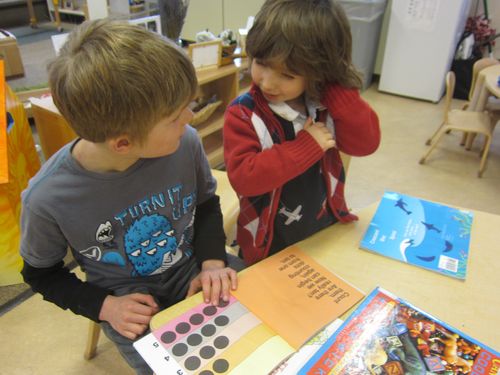
We enjoyed gathering with a small group of parents last week to dig deeper into the topic of perspective taking as it relates to children and the adults who work with young children. As we gained insight into the neurological complexity involved when the mind is actively engaged in taking on another’s perspective, we began to draw connections to what happens for children and adults while practicing this essential life skill.
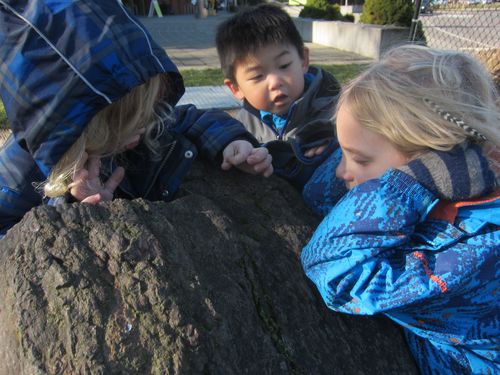
“I brought my son to the doctor recently. He has a great relationship with him, and is familiar and comfortable with him. But when the doctor greeted my son with an extended hand, my son backed away and refused to return his greeting. He does this with my parents too. For example, I might ask him to say, “Good Morning”, then when they see he is uncomfortable, they say, “No, no he doesn’t have to…” which doesn’t make the matter any better”
This story and others shared that evening inspired us to ponder the questions…
How do we gain insight into the child’s perspective to develop a better understanding of their actions?
What language might be useful in facilitating dialogue to reveal their perspective?
How do I balance trying to understand my child's perspective with what I value and want him to do?
How might we create a shared perspective so that he understands the awkward feeling of the other person who is not greeted?
What does it look like and sound like to share perspectives?
In Ellen Galinsky's book, Mind in the Making, she highlights all that is happening when perspective taking is involved.
"When you consider the tasks involved in perspective taking, it's not so surprising that the brain lights up in multiple places. Perspective taking involves intellectual skill of discerning how someone else thinks and feels; it requires assembling our accumulated knowledge of that person, analyzing the situation at hand, remembering similar situations, recalling what others have told us about such situations, putting aside our own thoughts and feelings, and trying to feel and think as another person must feel and think."
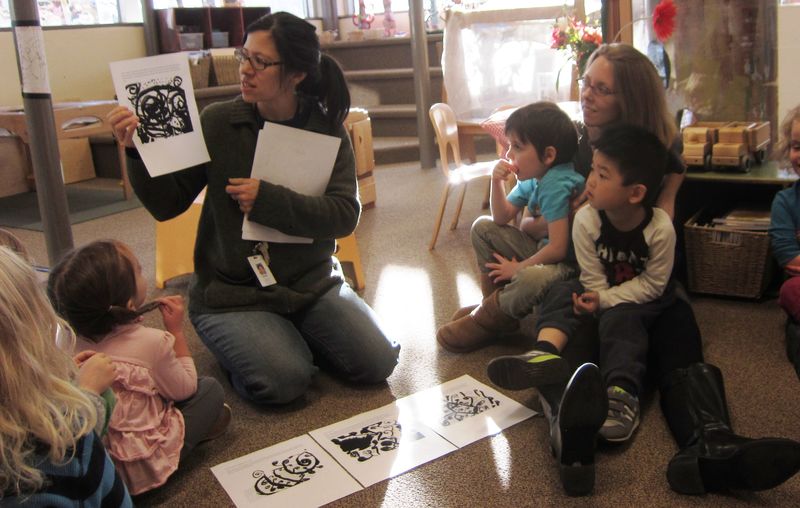
So, what are some of the ways in the classroom that we support children to develop the skill of perspective taking? It happens in our daily living within the classroom community, but we also have developed some structures to help us all work together to create shared meaning around these important ideas and skills. These structures allow everyone in the community the opportunity to listen to one another's perspectives, actively take on anothers' perspective, and to reflect together on how to move forward with the newly acquired information in a playful, safe, and non-emotionally-charged environment.
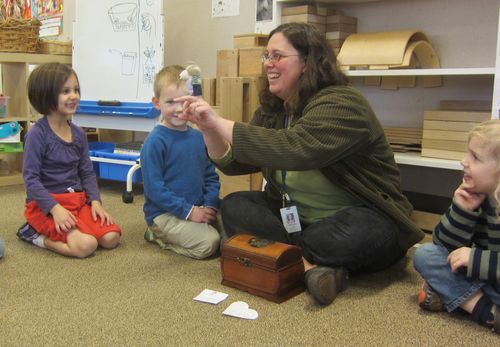
Probelm-solving Theater is a structure where the teachers, actually, puppets, share a problem that they have been having. They ask the children for help and the teachers help facilitate a group experience where they get to peel back the layers to uncover what might be going on in this problem. Teacher Theater is when Teacher Caroline and Teacher Kimie act out a story with the same intention as Problem-solving Theater. The stories and problems that are brought to the children are stories and problems that we have been observing in the classroom.
We then invite children to share their observations and their unique perspectives as a way to understand what support may look like for themselves and for other children.
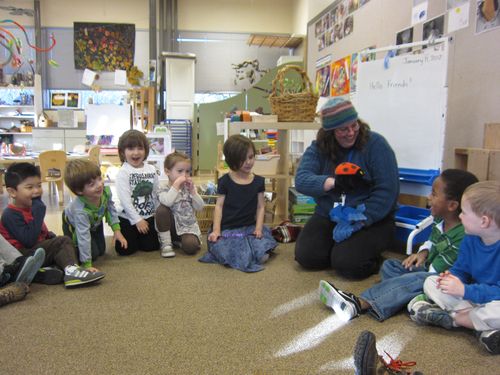
Below is a transcript of a recent Problem-solving Theater to help illustrate what it sounds like…
Caroline brings down Ladybug and Blue Jay who were inside the treasure box. They say hello to everyone. They ask if they can share a problem to get some help with from the children.
Everyone excitedly yells "yes!"
Caroline: Every day Ladybug and Blue Jay have been watching you build with blocks. They have been so excited by what they see that when you're not here they have been playing with blocks. They have been cleaning them up and putting them back on the shelf before we come to school each day.
Ladybug: Did you know we've been doing that?
No!
Recently we've been having a problem in the block area. Can you help us?
Yes!
Ladybug and Blue Jay share that they have been really inspired by watching you guys build a zoo that we decided to build a zoo too. Ladybug and Blue Jay build a cage out of blocks and put a wooden kitty in the cage. Then Ladybug says as she picks up the kitty "I want to take kitty for a walk in the zoo." At this Blue Jay says "But I want to…"as he grabs the kitty too. Ladybug and Blue Jay begin a tug of war and then suddenly the kitty falls to the ground.
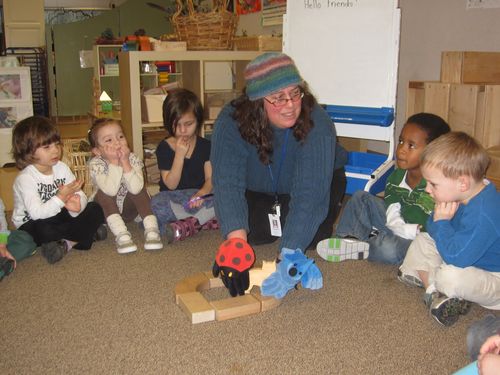 Caroline: So, here is their problem. What happened?
Caroline: So, here is their problem. What happened?
Many voices: Because it dropped down.
SM: and it falled.
FR: and they pulled it.
MG: Because Blue Jay had kitty cat and Ladybug wanted it.
SS: 'cuz when Ladybug was walking the kitty, Blue Jay snatched it from her.
SR: I have an idea.
Caroline: Oh great! That will be great to hear.
RN: the kitty broke.
MM: Blue Jay broke the kitty.
Caroline: How is Blue Jay feeling?
HF: sad
SE: sad
OB: Because Ladybug pulled and Blue Jay pulled the other way.
Caroline: Why else might Blue Jay be feeling sad?
SS: Because Ladybug had it and Blue Jay didn't.
Caroline: So let's think about how we might help Ladybug and Blue Jay solve this problem….
HF: I think they should share!
Caroline: What would sharing look like?
HF: That would look like not pulling.
OCu: Maybe they could get another animal.
SR: They could take turns. First Ladybug, then Blue Jay.
Ladybug: Oh I like that idea because I want to be first.
Blue Jay: Oh I don't like that idea because I want to be first. I want it right away.
SM: They can both play with it and both make it go to sleep or whatever they want to do and they can hold it on their lap.
MT: I think you should both ride on it together.
OCu: Maybe you could put two animals in the cage and have both.
WB: They could add another kitty.
AH: They could ride it together.
OB: Or kitty can get 3 piggies.
MM: They could play with the two kitties together.
WB: Then they wouldn't have to wait.
Ladybug and Blue Jay: Wow! Thank you so much for all of these wonderful ideas. We think we will try some of these next time if we have this sort of problem again.
The myriad possible solutions that the children collectively offered to Blue Jay and Lady bug are a testament to the power of perspective as a way to access and employ the highest executive functioning in the brain. These are complex, thoughtful, creative solutions, which were nurtured through taking the time to consider each view point. For this reason, we strive to incorporate perspective taking into much of what we do throughout the day, not only as a preemptive means for social conflicts, but also as we walk children back and reflect on what happened, while choosing one or two of the following questions:
Do you think she knew that would happen?
Do you think she wanted that to happen?
Do you think that is the message she got from your response?
Did you think that helped her to know what you wanted when you did that or not? What were you feeling when that happened?
How do you think she was feeling?
We will continue to share with you in the coming months several other structures for supporting this practice and look forward to hearing your feedback and experience with these ideas.







